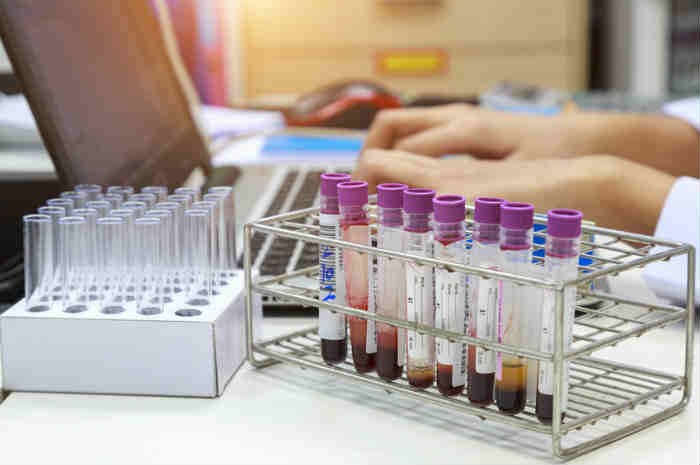
Creatinine, detection in blood and urine indicates kidney function
Creatinine measures the body’s ability to filter blood through the kidneys. It is determined on a normal blood or urine sample
Creatinine is a substance normally present in our muscles as a breakdown product of creatine
Creatine, a substance produced by the liver, kidneys and pancreas, is mainly transported to the muscles where it plays an important role in increasing muscle mass and endurance.
The creatinine level in the blood is proportional to muscle mass and remains constant over time
Creatinine disposal takes place through the kidneys, which filter the blood removing waste products of our metabolism.
Determination of creatinine levels is performed on a normal blood sample or in the urine. Its assay in 24-hour urine is routinely performed in patients with kidney disease to assess renal clearance.
Creatinine is used to measure renal clearance, i.e. the body’s ability to filter blood through the kidney’s glomeruli (GFR – Glomerular Filtration Rate). Using algorithms or specific formulas adapted to the gender, ethnicity and age of the patient, the filtration capacity of the kidneys can be estimated.
Thus, in the case of kidney failure, the creatinine concentration in the blood reflects the state of kidney failure
An accurate measure of the kidney’s ability to filter blood – renal clearance – is obtained by comparing the amount of creatinine released in the urine with its concentration in the blood.
However, calculating renal clearance requires a collection of urine output over 24 hours, and accurately collecting 24-hour urine is by no means simple.
Therefore, algorithms have been developed to calculate creatinine clearance from the blood creatinine concentration and other values such as the patient’s age, weight and gender.
The creatinine value is mainly influenced by kidney function while azotemia, a blood test frequently used to assess kidney function, is influenced to a greater extent by dehydration and diet
Although creatinine is not greatly affected by external factors such as diet, it is advisable to take the blood sample normally hydrated and without having eaten meat in the previous hours
The use of certain drugs that increase the activity of the renal tubules leads to a slight overestimation of its concentration.
Talking about normal creatinine values is rather complex as normal values for a man with large muscle mass might be abnormal for an elderly person or a child.
A normal creatinine concentration (creatininemia) for a young adult weighing 70 kg is between 0.67 and 1.17 mg/dL while in a child the values are significantly lower.
Usually, the renal clearance or GFR is calculated and taken into account: a normal GFR corresponds to a filtration of more than 100 ml/min.
In children, glomerular filtration begins at the sixth week of intrauterine life, but its actual function begins with extrauterine life.
The kidneys grow until the age of 20, but GFR only becomes comparable to that of the adult from the third year of life onwards.
Commonly, Cockcroft & Gault’s formula and Levey’s MDRD formula are used to estimate GFR from blood creatinine concentration
Variations of these formulas take into account different variables such as gender, ethnicity, age, weight, height, or other values such as albumin or azotemia.
In paediatrics, specific formulas are used, such as the ‘quadratic formula’.
Insufficient renal clearence, which corresponds to a GFR of less than 60 ml/min, supports the suspicion of renal insufficiency.
Low creatinine values normally occur in children and people with diseases related to poor muscle mass development.
Read Also:
Emergency Live Even More…Live: Download The New Free App Of Your Newspaper For IOS And Android
Kidney Stones: What They Are, How To Treat Them
What Is Albumin And Why Is The Test Performed To Quantify Blood Albumin Values?
What Is Cholesterol And Why Is It Tested To Quantify The Level Of (Total) Cholesterol In The Blood?
Gestational Diabetes, What It Is And How To Deal With It
What Is Amylase And Why Is The Test Performed To Measure The Amount Of Amylase In The Blood?
Adverse Drug Reactions: What They Are And How To Manage Adverse Effects
Kidney Stones: How They Form And How To Avoid Them
Renal Colic, How Does It Manifest Itself?
Biliary Colic: How To Recognise And Treat It
When The Patient Complains Of Pain In The Right Or Left Hip: Here Are The Related Pathologies
Organ Transport, The First European “Drone Ambulance” Debuts In Turin: It Will Transport Kidneys
What Is Pancreatitis And What Are The Symptoms?
Albumin Replacement In Patients With Severe Sepsis Or Septic Shock
Provocation Tests In Medicine: What Are They, What Are They For, How Do They Take Place?
What Are Cold Agglutinins And Why Is The Test Performed To Quantify Their Values In The Blood?


